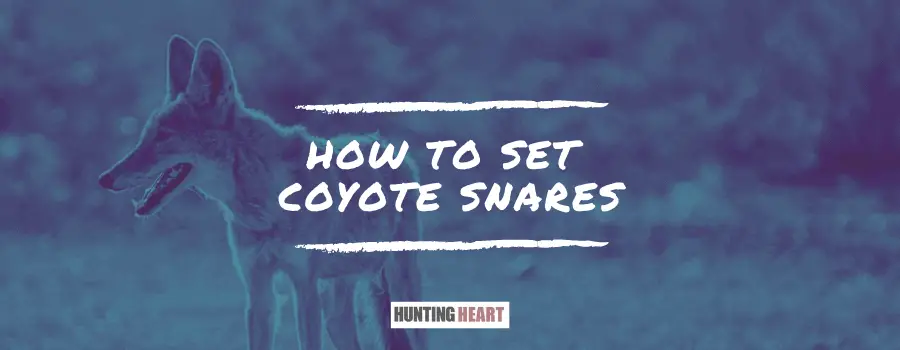As an Amazon Associate I earn from qualifying purchases.
Our Associate portal can be found here
Introduction
Snares are simple devices that can be used to effectively trap coyotes in certain situations. A snare is easy to make as it consists of a wire loop with a locking device that will tighten around the coyote’s body as it passes through the loop. The best place for a snare is to set it where the coyotes are crawling under a fence. However, you can also set them in trails in the brush, and at a den entrance.
The device must loop in a manner that the animal will put its head through the loop as it passes through a targeted area. The mechanism is basic. Once the snare is around the coyote’s body or neck, the more it pulls, the tighter the snare gets.
The best coyote snares are made of a flexible cable. The length of snares varies, depending on the size of the coyote but they are usually between 32 and 48 inches long. The snare should long to allow you to attach the end with a firm object. To use snares effectively, it is necessary to know all you can about the coyote’s habits.
Understanding Coyote Habits
Coyotes are creatures of habit, just like most animals. They are most active during late evening hours, and at night; you can easily hunt them at night. Coyotes have an acute sense of smell and rely on it when hunting for prey and avoiding danger. They also have keen eyesight that makes them nocturnal animals.
As creatures of habit, coyotes have established travel routes that they follow regularly in the areas they live in. The routes are usually along livestock trails, ranch roads, ridges, canyons, or any other place that offers easy travel and good visibility. A skilled hunter will be aware of these travel routes by looking for coyote signs such as droppings or tracks.
Coyote tracks are quite similar to dog tracks, but you can easily distinguish between the two. Dog tracks are usually larger than coyote tracks and are round with the toes spread apart. The toenail marks are usually visible on all toes. Coyote tracks are somewhat rectangular and the toes closer together. If you see any toe marks it will be only for the middle two toes. Also, dog tracks are somewhat staggered, while coyote tracks appear to be in a straight line.
Domestic dog droppings are unlike the coyotes as they feed on table scraps or dog food. A coyote’s dropping is called scat. It contains bone fragments and animal hair and it is what readily distinguishes a coyote’s droppings from that of a dog. Coyote scats are black but turn gray or white as they begin to weather.
The Steps to Setting a Coyote Snare
Getting the Right Equipment
One advantage of using snares is that there is only a minimum amount of equipment needed. A skilled trapper understands the need to prepare a supply of snares that are clean and ready to be placed in the field.
Preparation
To prepare snares for the field, you should place them in the open air for aging. It is a technique that helps to remove the oil on the cables. Snares should also be boiled for ½ hour in a mixture of ½ pound of baking soda per 3 gallons of water. You may add wax or trap dye if available.
Ideally, when you prepare your snares, ensure that they require minimal handling to set them up. It is a three-stage process that includes pricking in the tealer, attaching the snare to the anchor, and making adjustments. The more you handle snares between boiling and setting them, the greater the risk of the fox detecting the snare.
I also recommend the use of a pair of clean gloves. The gloves help to reduce the amount of human odor on the snares. Cotton or knit gloves are the best as you can launder them. Also, you will need some heavy wire, preferably a baling wire, to anchor the snare to the fence. Finally, a small thin wire or sewing thread should be used to hang the snare. The only other equipment needed is a pair of pliers for cutting and bending the wire.
Location of the Set
The best place to set a coyote snare is in holes through or under net wire fences where coyotes are entering and leaving a pasture. Remember to be observant for any coyote signs such as hair and tracks, on the fence. Digging will also indicate coyote crawls.
When you use coyote snares barbed wire fence, some coyotes may go through the fence between the wire strands, while many will dig and crawl under the bottom strand of the fence. You can determine coyote crawls under fences by following their trails through the grass or bush leading up to the fence. You should always take care when using snares to avoid trapping other non-targeted animals such as deer, rabbits, and javelinas.
Making the Set
As a skilled trapper, I sometimes prefer to use a drag instead of attaching the snare to the fence. The reason is that once caught, the coyote will pull the drag away from the fence and keep the trap site from being disturbed. The loop can vary in size but for a coyote, it should be between 8 and 10 inches in diameter when set. If the loop size is small, the snare will be knocked down when the coyote crawls under the fence.
The snare should be directly under the fence and the top of the loop should be attached to the fence using a small, thin wire or a single strand of sewing thread. It helps to keep the snare in the proper upright position, but allow it to be released with the slightest pull.
Scent
You must pay attention to scent as it helps enormously. I recommend that you set snares in the morning so that it has more time to lose the human scent left on the snare. Setting it early also preserves the snare set and has the greatest chance of dissipating before nightfall. One way of preserving the set is to use water and a scent-free soap for washing your hands thoroughly when you arrive at your snaring site.
You should wash your hands before handling the snares but remember to remain to do so well away from your first snare site. Rub your hands with freshly exposed soil. The soil helps to prevent your scent from getting onto the snare or surrounding vegetation. To further minimize your scent, wear clean rubber boots when setting snares.
Avoid kneeling in the run when setting the snare, always crouch. It prevents your scent to readily transfer from your trouser knees to the ground. However, the rubber boots will mask your scent. It may seem tedious but masking your scent is vital when setting up coyote snares.
Footwork
While setting the snare, do not stand to one side of the run, as a coyote will also diverge from the run to see what you did there, and probably miss the snare. You can put a snare on a track that you walk on daily. But ensure that you place your feet along the track close up to the snare on both sides. It helps keep the track trodden.
Be careful not to take a wide step over the snare, as coyotes too will leap over it. Never walk around the snare when setting it. Sometimes the coyotes tend to follow the easiest path.
Checking the Set
You should make it a habit of checking snares daily. A snare is designed to kill coyotes when it closes around the neck, however, sometimes it catches the coyote around its body. Occasionally, the coyote may eventually pull and chew on the cable and break it. By checking snares daily you will not lose any coyote your snare traps.
To minimize disturbance at the set location, approach the set just close enough to see if a coyote is trapped or if the snare is still in place.
After you trap a coyote successfully, you should use a new snare at the trap site. The reason is that a coyote will bend and twist the cable and the snare. Both will be destroyed but you can remove the swivel and locking device for use on another snare.
Types of Snare Traps
All snare traps use a snare, which is also called a noose. It is a wire or cord loop that tightens around the prey.
The snare can either tighten from the coyote’s movements or by energy from a spring. Ordinarily, the spring is a sapling tree. A snare can sometimes have a triggering mechanism.
There are different types of triggers, such as the pencil snare and the rolling. You can make both snares using only a few sticks and a knife.
Alternatively, the snare trap sometimes has no trigger or spring and merely attaches to a heavy anchor. Such snares are known as freestanding snare traps. All of the mentioned snares are typically sized to catch small animals. But snares can also be sized to catch larger prey, such as deer.
Popular Coyote Hunting Accessories
Amazon and the Amazon logo are trademarks of Amazon.com, Inc, or its affiliates.

36 years old, been hunting and fishing my entire life – love the outdoors, family, and all kinds of hunting and fishing! I have spent thousands of hours hunting hogs and training hunting dogs, but I’m always learning new stuff and really happy to be sharing them with you! hit me up with an email in the contact form if you have any questions.


